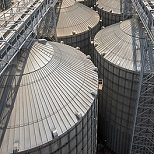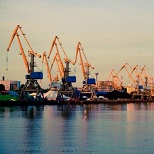Black sea blues
Ukraine’s traditional ports face turbulent times as public-private relations froze over after legislation turned against investors and operators. Can post-election Ukraine turn the tide and regain the confidence of international investors?
The Ukrainian Port Sector and especially the Ukrainian Public Port Authorities such as the Odessa and Illichevsk Sea Commercial Ports are rapidly losing private sector interest as the Ukrainian central government in Kiev has proved to be unable to create a sustainable, stable and competitive port business environment for private entrepreneurs to invest in. The country, with its eyes both on the EU and Russia, holds a significant transit potential and with the expected economic developments the transport sector is expected to flourish once more. To implement these economic developments and to unlock its economic value, Ukraine is relying on both foreign direct investments (FDI) from international operators and soft loans provided by International Financial Institutions such as the EBRD. This is however where the shoe pinches.
There is a multitude of institutional issues lying at the basis of the problems currently identified in Ukraine. Amongst them is a basic lack of experience in attracting and managing international private partners and specific governmental policies which have expelled and continue to deter private investors from the country’s port sector. A closer look at these matters seems relevant here.
Joint Activity Agreements
Although the country’s independence in 1991 meant a significant change in its economic policy, Ukraine’s administration still has a hard time opening up to private capital in its port sector. On the contractual side, there are the Joint Activity Agreements (JAAs), Ukraine’s draconian interpretation of a public-private partnership. In this scheme both the public port authority and the private operator are formally linked in a single commercial entity which develops and operates the terminal facility. Where the general believe is that public and private interests need only to be managed and formalized through a concession agreement, the Ukrainian interpretation of this believe is however rather different, turning the operating company’s boardroom into a public-private battlefield, paralyzing the operator organization where it comes to making investment-decisions and managing the operations. This is clearly not optimal basis for setting up a long-lasting and value-driven relationship between a public authority and its concessionaires.
Recently one of the JAA arrangements turned to the worse in Illichevsk, just south of Odessa, where NCC subsidiary Ukrtranscontainer was forced out of the port after a legal dispute with Illichevsk Sea Commercial Port. The local Port Authority accused its private JAA partner of violating many clauses of the JAA, including clauses on timing and currency of fee payments, financing of (non) joint-activity assets and allocation of (non) joint-activity operational expenses. The legal dispute was carried to the highest court in the country, but Ukrtranscontainer finally lost the case, the JAA was annulled and the private operator had to seize its container handling activities in the port. The operations at the 850,000 TEU facility (to be expanded to 4 mTEU by 2020) are currently managed by the public authority itself. Disputes such as these make private investor think twice and even thrice before entering in such unique arrangements and committing to making significant port investments.
Auctions
Selection of suitable private investors also proves to be an arduous task in Ukraine. Nearly everywhereauthorities use tendering as a tool to select the most suitable investor/operator for its scarce and strategic terminal assets. In Ukraine tender procedures are known as auctions and in principle they are organized by the Port Authorities managing the public port assets. With Resolutions 703 and 530, the Kiev prides itself in having a clear formalized procedure for organizing such auctions. Problem in Ukraine is however, that these processes can still not provide sufficient comfort to the private sector.
First of all, the project and contract specifications continuously change over time due to ongoing formal involvement of a variety of public institutions, such as the Ministries of Transport, Finance, Economic Affairs, the State Property Fund and of course the Public Port Authority themselves. These entities all need to give their formal approval and all can request amendments.
Second, there is no clear timing with regards to these forms of public participation making it an infinite process resulting in escalating transaction costs. What is basically auctioned here is the exclusive right to enter in negotiations for an investment agreement with the public authority.
Third, private operators primarily base there investment decisions on the feasibility and bankability of the Business Case. In Ukraine the authorities are often unable to provide potential investors with reliable and timely information with regards to investment timing and allocation, operational timing and tariff policies.
A good example of Ukrainian tender procedures not leading to secured private involvement can be seen in the port of Odessa. Here the Odessa Sea Commercial Port has encountered recurring setbacks with bringing a major container capacity expansion to the market. The envisaged Greenfield project, adjacent to the existing HPC facilities, has not been able to attract many international bidders for the second time in a row now.
Looking Forward
The issues addressed in this article have to be dealt with by the private sector in the best way possible. Main result for now is however that the main public ports of Odessa and Illichevsk cannot attract much needed private capital and expertise: Ukrtranscontainer had to leave Illichevsk; APMT has not made any headway in the same port; Odessa is still looking for private investors and was only able to provide CMA-CGM with a small plot recently.
Meanwhile in Yuzhny, only 35 kilometers to the east of Odessa, the 430,000 TEU facility of private operator TIS has been developed. With only minor public involvement it is expected that, unless Kiev reiterates its position towards the private sector, this terminal will be safe haven for capacity developments in the coming years (phase 2 in 2012: 1.8 mTEU).
If this situation is not improved soon, the country’s traditional Commercial Ports will continue to loose market share and they will be unable to compete to international and domestic initiatives. In this situation, financial and economic value might be lost at the expense of the electorate. Kiev now holds the key in turning the tide: Will the post-election administration be pro-active in paving the way to value creating Public-Private Partnerships in the Ports of Ukraine, or will developments come to a stand-still at this important part of the Black Sea?

Probing Virgin Ground: Worries of international consultants in Ukraine Ukraine’s long proclaimed struggle for the foreign direct inve...
.jpg)
Ukrainian Law on Inland Water Transport Finally in Force President of Ukraine Volodymyr Zelensky has signed the Law on In...

Feasibility study for the concession of the container terminal “Chornomorsk” ready in early 2021 The working Group on the implementation...
 November Transport, Shipping & Port News2020.12.04
November Transport, Shipping & Port News2020.12.04Dear Reader! Our monthly digest is confined to ports, terminals, shipping and transport of Ukraine. Ukrzaliznyts...

Ukraine as a littoral state commanding most of the Black Sea north coast along with the Azov Sea north occupies a strate...
 Opportunities in the Ukraine2019.07.10
Opportunities in the Ukraine2019.07.10At the moment there is a concession pilot project conforming to European norms under way for the public stevedoring companies in Olvia (form...
 Endgame or a Path to Possibilities?2019.05.24
Endgame or a Path to Possibilities?2019.05.24Ukrainian port industry is growing rapidly and the upcoming vote for concession legislation should only confirm this trend. ...

1. Who’s pushing? The acting Cabinet of Ministers led by Volodymyr Groisman initiated the draft law development in summer 2016. The EBRD...
 A step in the right direction2018.08.27
A step in the right direction2018.08.27For years, it has been the worst-kept secret for any foreign investor that port concession tender conditions in Ukraine were often drafted t...

Until recently, investing in Ukrainian port infrastructure was considered quite risky, due to an outdated regulatory framewor...




 Odessa, 65014, Ukraine, 1 а, Gretska St
Odessa, 65014, Ukraine, 1 а, Gretska St
